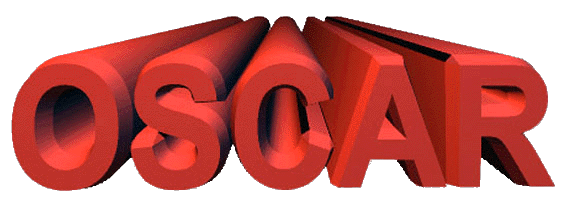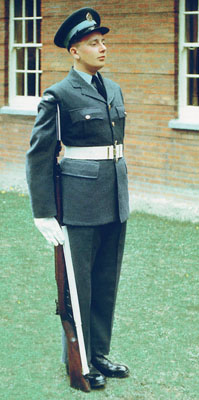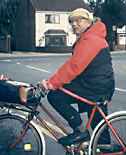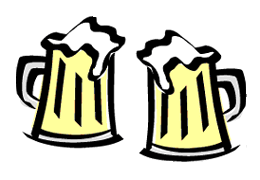
The Incredible

STORY
This is a brief history of my life on and off the Web. It is, of course, on going. You may feel the urge to skip down to the end to see what I have been up to recently.
 The Early Years
The Early Years
- 1941-1957
-
- I was born in Ramsgate in the middle of an air-raid on the nearby airfield at Manston in 1941 but lived for all of my formative years in Canterbury. My interests in both aviation and photography began during these tender years. My earliest memories include running for shelter from doodle-bugs and marauding red-nosed Focke-Wulfs and watching the aerial armadas on D-day. By the time I started school in 1947 I could recognise most types of aircraft by their sound, often long before they were visible! I was given my first access to a camera in 1953, a pre-war, art-deco styled, bakelite Kodak Baby Brownie that took 127-size film. The first photograph I ever took was of the band of the Royal East Kent Regiment ("The Buffs") leading the regiment's freedom of the city of Canterbury parade. As I was an enthusiastic builder of scale model aeroplanes, paticularly WWII German bombers, I was soon experimenting with methods to picture these "bombers" over the local rooftops! In 1955 I joined No.312 (Canterbury) Squadron, Air Training Corps which further increased my enthusiasm about all things aviation and also made me proficient in reading/sending Morse Code. About this time I became less than impressed by the processing results from my local "Timothy Whites & Taylors" chemist's branch and soon resorted to developing and contact-printing my own films. My preferred film was Ilford Selochrome Pan although buying a film in those days was very much "Hobson's choice"! Clutching camera and notebook I went to my first airshow, at Manston, in 1956 with my schoolfriend Philip Miller and his dad. The highlight for me was the appearance in the static park of an F-86H Sabre on a rare visit to the UK but the RATO take-offs by a B-47B and an SA-16A were impressive, too.
- Much to the relief of my
headmaster I left grammar school in 1957 and joined the Royal Air
Force as an apprentice at the ripe old age of fifteen and a half. 28
years of service followed, working as an instrument fitter, and
later as an electronic technician, on Vulcan, Canberra, Britannia,
Comet and Phantom aircraft.
 The Middle Years
The Middle Years
- 1957-1985
-
- Several things happened in the latter part of 1957. I left school, my sister bought me a Kodak Brownie 127, I began my training with the 87th entry of Aircraft Apprentices at RAF Halton and joined the station photographic club. Before the year was out I had acquired my first 35 mm camera from Vines Cameras at Harrow on the Hill. It was a FAF (Moretti) Acies, made in Venice, an innovative but truly awful camera. I could not get a good photograph out of it, every attempt appeared to have been taken through the bottom of a dirty milk bottle! After only three weeks I took it back to Vines' and traded it in as the deposit on the first of what was to become a pair of Braun Super Paxettes. I later added 35, & 135 mm lenses to the outfit along with a Gossen Sixtry exposure meter. I also began taking some medium format shots with a Kodak Junior II that I had acquired as the results of a wager! It was a folder that took 120-size film and really needed a tripod to get the best out of it. My off-duty days were now filled by hitchhiking round the country taking photos at air shows and active airfields and by developing and printing the pictures I had taken. In late 1958 I processed my first colour film, a High-Speed Ektachrome 160asa., process E-2, which took as I recall, 11 baths and 14 washes! 1959 saw me elected president of the RAF Halton photographic club, this meant I got to use the club's Speed Graphic!
 Meanwhile, I was doing plenty of D & P work for my friends which
enabled me, in December, to trade in my Paxettes for a Pentacon FM
with 50 & 180 mm Tessar lenses. This was the first SLR to be
owned by anyone in the club and it created quite a stir,
particularly as the shutter made a noise like a portcullis coming
down! 1960 was a year I can never forget. At the end of my
apprenticeship I passed my final exams with flying colours only to
be told by the civilian authorities that they would not give me my
Ordinary National Certificate in Electrical & Mechanical
Engineering as my three years' collection of notebooks were not neat
enough and that I had "fiddled" the results of a first
year lab experiment! I was inspired to tell the buffoons in words of
one syllable just what they could do with their blasted certificate!
Anyhow, as a consolation prize I got accelerated promotion to
Corporal in one year instead of three! I was now 18 and got posted
to Scampton to join 617 Sqn., "The Dam Busters", who were
equipped with Vulcan B.1s. In October I learned that I had been
awarded the Lawrence Deane Memorial Trophy by the Royal Aeronautical
Society for the best junior member's paper of the year. It was for a
lecture I had given earlier in 1960 to the Society about
airline-specified modifications to the Viscount airliner. It was
liberally illustrated with my own photographs and given to an
audience of around 300 aviation buffs including officers of Air Rank
and high-ups from the aviation industry. Not bad for 18! I went on
to pursue an exciting but undistinguished career in the RAF all the
time on the look out to take pictures of aeroplanes whenever and
wherever the opportunity arose.
Meanwhile, I was doing plenty of D & P work for my friends which
enabled me, in December, to trade in my Paxettes for a Pentacon FM
with 50 & 180 mm Tessar lenses. This was the first SLR to be
owned by anyone in the club and it created quite a stir,
particularly as the shutter made a noise like a portcullis coming
down! 1960 was a year I can never forget. At the end of my
apprenticeship I passed my final exams with flying colours only to
be told by the civilian authorities that they would not give me my
Ordinary National Certificate in Electrical & Mechanical
Engineering as my three years' collection of notebooks were not neat
enough and that I had "fiddled" the results of a first
year lab experiment! I was inspired to tell the buffoons in words of
one syllable just what they could do with their blasted certificate!
Anyhow, as a consolation prize I got accelerated promotion to
Corporal in one year instead of three! I was now 18 and got posted
to Scampton to join 617 Sqn., "The Dam Busters", who were
equipped with Vulcan B.1s. In October I learned that I had been
awarded the Lawrence Deane Memorial Trophy by the Royal Aeronautical
Society for the best junior member's paper of the year. It was for a
lecture I had given earlier in 1960 to the Society about
airline-specified modifications to the Viscount airliner. It was
liberally illustrated with my own photographs and given to an
audience of around 300 aviation buffs including officers of Air Rank
and high-ups from the aviation industry. Not bad for 18! I went on
to pursue an exciting but undistinguished career in the RAF all the
time on the look out to take pictures of aeroplanes whenever and
wherever the opportunity arose.
- I did, however, lose interest in photography (but not aircraft) for a few years in the late 1960s. I taught myself to play trumpet and tenor sax so that I could play traditional jazz. I played and sang with several amateur jazz bands before Beatlemania knocked the bottom out of the jazz market and I picked up my camera again. However, I played cornet, flugelhorn and tenor horn with several different brass and military bands until the late 1970s.
- In the years from 1953 to 1984 I was very active in the field of scale aircraft modelling, at first in wood and later in plastic. I was a well-known member of the International Plastic Modellers' Society and contributed illustrated articles and kit reviews to the Society's magazines in both the UK and the USA. For several years I contributed illustrated kit reviews to "Scale Models" and "Scale Aircraft Modeller" magazines on a monthly basis. Because of this the world's leading manufacturers sent me review samples of their latest kits and often asked me for advice before going into production. I still have several hundred unmade kits in my loft, many of them collector's items. My modelling articles have been published in the USA, South Africa, New Zealand and Czechoslovakia. Over the years I have had aviation articles and photos printed in magazines such as "Aircraft Illustrated", "Aeroplane Monthly" and "Aviation News" as well as many books for the aircraft enthusiast. In more recent times I have had two illustrated articles published in "Practical Photography" magazine, one was a "how to do it" item on taking photos at air displays and the other was on advanced techniques in printing with Ilford "Cibachrome" materials. This latter was translated and used in the journal of the Danish National Photographic Society. My pictures have often been published in "Amateur Photographer" magazine, the late lamented Mr. Blackman once said that one effort of mine was the finest example of Cibachrome printing that he had seen. Mike Maloney also made a shots of mine his picture of the week on two occasions.
- Two points of interest but no
relevance. Firstly, an agent from Liverpool at one time wanted to
buy my discharge from the RAF and set me up on the club circuit as a
compère-comedian. Not only that, but I was also one of the
ceremonial trumpeters that played the Bliss Occasional Fanfare No.6
at the Royal Première of the "Battle of Britain"
film at the Gaumont, Manchester!
- While stationed at RAF Coningsby
in 1978 I was told by the MO to lose weight. I decided to give up
lunch and do something productive with the time to keep my mind off
food! In six months I had built myself a field camera, made of wood
(from a wrecked NAAFI piano) with metal brackets and fittings, it
had all the required movements and looked a little like a vintage
Gandolfi. It was designed to take standard 5x4 darkslides and a 120
rollfilm back. Construction costs worked out to a touch under £5.00!
I equipped it with a Rodenstock Syronar N 150 mm lens in a Copal
shutter. It functioned splendidly from the word go and remains part
of my tool kit to this day.
- About this time I realised that
some of my early images were the worse for wear after years of being
carted around from one posting to another so I set about learning
the noble art of retouching in order to restore them as and when
needed. Fortunately, all those years spent making models had endowed
me with reasonable skill with small brushes and the airbrush. It was
all time well spent as these retouching skills were to pay dividends
in years to come.
- I did three overseas tours of duty, in Singapore, Germany and the Falkland Islands, and also completed detachments in 25 other countries on five continents. In 1985, having finally had enough of the bungling inadequacies of the service's administration department, I took early retirement.
 Recent Events
Recent Events
- 1985 to Date
-
 Click here to e-mail Oscar or use the link
oscar@oscarpix.co.uk
Click here to e-mail Oscar or use the link
oscar@oscarpix.co.uk
 Back to Oscar's Open House
Back to Oscar's Open House
This page was created using  3
3



 Meanwhile, I was doing plenty of D & P work for my friends which
enabled me, in December, to trade in my Paxettes for a Pentacon FM
with 50 & 180 mm Tessar lenses. This was the first SLR to be
owned by anyone in the club and it created quite a stir,
particularly as the shutter made a noise like a portcullis coming
down! 1960 was a year I can never forget. At the end of my
apprenticeship I passed my final exams with flying colours only to
be told by the civilian authorities that they would not give me my
Ordinary National Certificate in Electrical & Mechanical
Engineering as my three years' collection of notebooks were not neat
enough and that I had "fiddled" the results of a first
year lab experiment! I was inspired to tell the buffoons in words of
one syllable just what they could do with their blasted certificate!
Anyhow, as a consolation prize I got accelerated promotion to
Corporal in one year instead of three! I was now 18 and got posted
to Scampton to join 617 Sqn., "The Dam Busters", who were
equipped with Vulcan B.1s. In October I learned that I had been
awarded the Lawrence Deane Memorial Trophy by the Royal Aeronautical
Society for the best junior member's paper of the year. It was for a
lecture I had given earlier in 1960 to the Society about
airline-specified modifications to the Viscount airliner. It was
liberally illustrated with my own photographs and given to an
audience of around 300 aviation buffs including officers of Air Rank
and high-ups from the aviation industry. Not bad for 18! I went on
to pursue an exciting but undistinguished career in the RAF all the
time on the look out to take pictures of aeroplanes whenever and
wherever the opportunity arose.
Meanwhile, I was doing plenty of D & P work for my friends which
enabled me, in December, to trade in my Paxettes for a Pentacon FM
with 50 & 180 mm Tessar lenses. This was the first SLR to be
owned by anyone in the club and it created quite a stir,
particularly as the shutter made a noise like a portcullis coming
down! 1960 was a year I can never forget. At the end of my
apprenticeship I passed my final exams with flying colours only to
be told by the civilian authorities that they would not give me my
Ordinary National Certificate in Electrical & Mechanical
Engineering as my three years' collection of notebooks were not neat
enough and that I had "fiddled" the results of a first
year lab experiment! I was inspired to tell the buffoons in words of
one syllable just what they could do with their blasted certificate!
Anyhow, as a consolation prize I got accelerated promotion to
Corporal in one year instead of three! I was now 18 and got posted
to Scampton to join 617 Sqn., "The Dam Busters", who were
equipped with Vulcan B.1s. In October I learned that I had been
awarded the Lawrence Deane Memorial Trophy by the Royal Aeronautical
Society for the best junior member's paper of the year. It was for a
lecture I had given earlier in 1960 to the Society about
airline-specified modifications to the Viscount airliner. It was
liberally illustrated with my own photographs and given to an
audience of around 300 aviation buffs including officers of Air Rank
and high-ups from the aviation industry. Not bad for 18! I went on
to pursue an exciting but undistinguished career in the RAF all the
time on the look out to take pictures of aeroplanes whenever and
wherever the opportunity arose. Although I had time off for a heart attack and operations on arthritic appendages I was party to this schizophrenic lifestyle until December 2005 when I had a bad attack of knees and had to accept medical redundancy from the Post Office. Although mostly retired from the frenetic, sharp-elbowed professional world I am still active on the photo club scene, and have been registered with the Photographic Alliance of Great Britain as a lecturer and competition judge for several years. I seem to be spending more and more time talking about photography than actually "doing" it! I do put a lot of shots from my personal files onto the fotoLIBRA and Redbubble online agencies and supply historic prints for mostly local sale. Nowadays I spend a lot of time converting the "real" photos in my archive to digital format for agency use and the occasional framed print.
Although I had time off for a heart attack and operations on arthritic appendages I was party to this schizophrenic lifestyle until December 2005 when I had a bad attack of knees and had to accept medical redundancy from the Post Office. Although mostly retired from the frenetic, sharp-elbowed professional world I am still active on the photo club scene, and have been registered with the Photographic Alliance of Great Britain as a lecturer and competition judge for several years. I seem to be spending more and more time talking about photography than actually "doing" it! I do put a lot of shots from my personal files onto the fotoLIBRA and Redbubble online agencies and supply historic prints for mostly local sale. Nowadays I spend a lot of time converting the "real" photos in my archive to digital format for agency use and the occasional framed print.
![]() Click here to e-mail Oscar or use the link
oscar@oscarpix.co.uk
Click here to e-mail Oscar or use the link
oscar@oscarpix.co.uk![]() 3
3